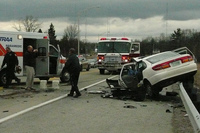Excessive passive voice, linguistic detachment observed in Culpeper road fatality
No news story ever began saying, “A person was killed yesterday when he collided with a bullet moving at high speed in the opposite direction.” Yet that’s exactly how news stories about traffic “accidents” often begin, like this Post story:
Four people ranging in age from 19 to 21 were killed early yesterday in Culpeper County, Va., when their car collided with a vehicle that was going the wrong way, Virginia State Police said.
Police said a Chevy Tahoe sport-utility vehicle was driving on the wrong side of a two-lane stretch of Route 3 when it struck the Toyota Corolla about 2:50 a.m.
I didn’t know cars could drive themselves, except maybe those in the DARPA Urban Challenge. And it doesn’t appear one of those robotic cars was responsible for yesterday’s crash in Culpeper. Yet the Post story words itself as though the car drove itself. Of course, a human was driving the car. Neither did the story write itself. We should say, Post reporter Martin Weil wrote, “The driver of the Tahoe was identified as a 29-year-old man.” (Identified by whom?)
Just based on the facts in the Post article, we can say, “A 29 year old man was driving his Chevy Tahoe SUV on the wrong side of Route 3 early yesterday when he struck and killed four people in a Toyota Corolla.” Why can’t the printing press at the Washington Post say that?
Many fields use too much passive voice. MRI reports, for example, read like this: “Mild Straightening of the cervical lordosis is demonstrated. Mild mucosal thickening is incidentally noted at the floor of the sphenoid sinuses.” The straightening didn’t observe itself. The doctor observed it. Why not just say that on the report?
After doctors, journalists writing about car crashes seem to overuse passive voice the most. Though we only seem to do this for cars, not for bicycles. In the excellent book Traffic: Why We Drive the Way We Do (and What It Says About Us), author Tom Vanderbilt (and not any inanimate object) writes,
In a study, [Ian Walker of the University of Bath in England] had subjects look at various photographs of traffic and describe what was going on. When subjects saw a photograph with a car, they were more likely to refer to the photo’s subject as a thing. When subjects looked at a picture that showed a pedestrian or a cyclist, they were more likely to use language that described a person. It somehow seems natural to say “the bicyclist yielded to the car,” while it sounds strange to say “the driver hit the bicycle.” In one photograph Walker showed, a woman was visible in a car, while a man on a bike waited behind. Although the woman could be clearly seen in the car, she was never referred to as a person, while the cyclist almost always was. Even when she was visible she wans rendered invisible by the car.
Vanderbilt goes on to explain how this psychological bias creates real safety consequences. When we see a cyclist, we tend to look at his or her face. That triggers complex cognitive processing, like trying to identify the person or discern his or her emotions. Those automatic brain functions are great when you see a person across a room or in a dark alley and need to figure out if you know him or her or whether he or she is a threat, but in traffic, it can distract important brain cycles away from the task of not hitting the bicyclist.
Finally, our habit of dehumanizing the actions of cars tends to create assumptions that their actions are not actually someone’s responsibility. A driver hit and killed some people in another car in Culpeper. It’s extremely unlikely his car magically malfunctioned. And even if it did, we don’t engage in the same linguistic contortions to say, for example, that a police officer’s bullet impacted a suspected robber, who had himself been holding a gun which fired into someone else earlier in the day. That would be silly. So is this.

